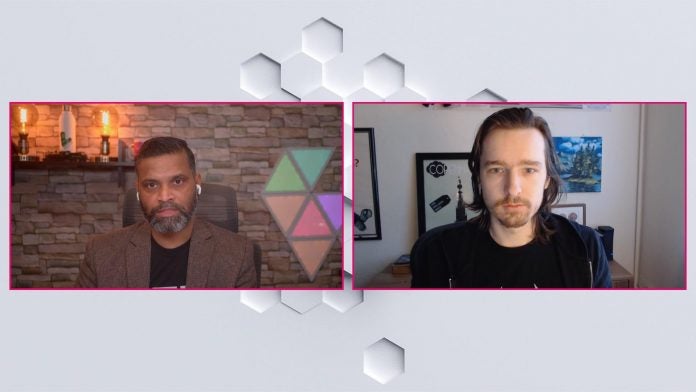Notes on BPF: Building applications using libbpf
Click to Read More at Oracle Linux Kernel Development
BPF: Application Development and libbpf
Introducing the Production Engineering Track of the MLH Fellowship, powered by Facebook
This article was originally posted at Major League Hacking
This Summer, Major League Hacking (MLH) is launching the Production Engineering Track of the MLH Fellowship, powered by Facebook. This is a 12-week educational program that will use industry leading curriculum from the Linux Foundation Training & Certification and hands-on project-based learning to teach students how to become Production Engineers. The program will provide opportunities to 100 aspiring software engineers to broaden their skills and career options, by learning important Production Engineering and DevOps skills. The program will run between June 7 – August 30, 2021 and will be open to United States, Mexico, and Canada based students who are enrolled in a 4 year degree granting program. Applications are open and will run until May 28, 2021.
What is Production Engineering anyway?
Early career software engineers are passionate and motivated to learn new skills and create a positive impact on the world, but many have not been exposed to the wider array of career options that are available to them. Production Engineering, also known as Site Reliability Engineering and DevOps, is one of the most in-demand skill sets that leading technology companies are hiring for, yet it is not widely available as an educational option in university settings.
Production Engineers (PEs) at Facebook are a hybrid between software and systems engineers and are core to engineering efforts that keep Facebook running smoothly and scaling efficiently. PEs work within Facebook’s product and infrastructure teams to make sure their products and services are reliable and scalable. This means writing code and debugging hard problems in production systems across Facebook services like Instagram, WhatsApp, and Oculus as well as backend services like Storage, Cache and Network.
What is the Production Engineering Track of the MLH Fellowship?
Initially launched in Summer 2020, the MLH Fellowship pairs early career software engineers with widely used open source projects like React, Jest, Docusaurus. This gives them the opportunity to apply their knowledge to real world projects, which helps them learn important concepts and patterns while also having production-level code to showcase in their portfolio. Through the Fellowship, MLH has created opportunities for hundreds of developers from around the world to level up and hone their skills in a 12-week cohort surrounded by peers and expert mentors. The Production Engineering Track takes this proven model and expands it to a broader range of technology disciplines, creating even more valuable opportunities for developers starting off their careers.
Program participants will gain practical skills thanks to educational content from Linux Foundation Training & Certification’s LFS201 – Essentials of System Administration training course, which covers how to administer, configure and upgrade Linux systems, along with the tools and concepts necessary to efficiently build and manage a production Linux infrastructure. By pairing this industry leading curriculum with hands-on project-based learning, students in the Production Engineering Track can build on their foundational software engineering knowledge to learn a broader array of technology skills and open the door to a variety of exciting and challenging new career options. Creating these types of non-traditional learning experiences helps empower developers from many diverse backgrounds and educational institutions to accelerate their careers and make an impact on the world.
Who is eligible?
The Production Engineering Track starts in June, and guarantees a $3,600 educational stipend to each participant. Applications are open now until May 28, 2021. Eligible students are rising sophomores or juniors who are United States, Mexico, and Canada based, enrolled in a 4 year degree granting program, and able to code. MLH invites and encourages people to apply who identify as women or non-binary. MLH also invites and encourages people to apply who identify as Black/African American or LatinX. In partnership with Facebook, MLH is committed to building a more diverse and inclusive tech industry and providing learning opportunities to under-represented technologists.
The post Introducing the Production Engineering Track of the MLH Fellowship, powered by Facebook appeared first on Linux Foundation – Training.
Error handling in Bash scripts
Let your Bash script help you find its errors with error handling.
Read More at Enable Sysadmin
Bash scripting: Moving from backtick operator to $ parentheses
Bash scripting: Moving from backtick operator to $ parentheses
Are you hooked on backticks in your shell scripts? You should consider $ parens.
Roberto Nozaki
Mon, 4/26/2021 at 7:49pm
Image
Image by Arek Socha from Pixabay
There are certain commands or tricks that you start using as a sysadmin, which you simply incorporate into your arsenal and never really stop to analyze in-depth all the options or alternatives to them.
Topics:
Linux
Linux Administration
Command line utilities
Read More at Enable Sysadmin
6 lesser-known but seriously useful Linux commands
6 lesser-known but seriously useful Linux commands
Introducing six (possibly) unfamiliar commands that you need to know.
khess
Mon, 4/26/2021 at 7:35pm
Image
Image by Gerd Altmann from Pixabay
People are creatures of habit. That assertion has both good and bad connotations. The good is that we tend to do things the same way every time we do them. The bad part is that we don’t tend to venture out from our routines. That routine keeps changes consistent and surprises to a minimum. The last thing any sysadmin wants to hear another sysadmin say is, “Whoops.” But, that’s a whole other story. Today’s topic is unfamiliar commands. Six unfamiliar commands to be exact. I think you’ll like these because they’re useful and outside the peripheral vision of most sysadmins.
Topics:
Linux
Linux Administration
Command line utilities
Read More at Enable Sysadmin
Video: Open Policy Agent Is Now A CNCF Graduate
OPA, or Open Policy Agent, is one of the most popular open-source tools for administrators to have fine-grained control for their cloud-native environment. The project was created by Styra and contributed to CNCF. The project recently graduated from CNCF to join matured projects like Kubernetes. Torin Sandall, VP of Open Source at Styra, sat down with Swapnil Bhartiya, CEO of TFiR and host of video interviews at Linux.com, to talk about the significance of graduation for a project like OPA which is already being used in production, the importance of OPA in the cloud-native world and what are some of the most exciting use-cases of the project.
OpenAPI Specification 3.1.0 Available Now
Introduction
The OpenAPI Initiative (OAI), a consortium of forward-looking industry experts who focus on standardizing how APIs are categorized and described, released the OpenAPI Specification 3.1.0 in February. This new version introduces better support for webhooks and adds 100% compatibility with the latest draft (2020-12) of JSON Schema.
Complete information on the OpenAPI Specification (OAS) is available for immediate access here: https://spec.openapis.org/oas/v3.1.0 It includes Definitions, Specifications including Schema Objects, and much more.
Also, the OAI sponsored the creation of new documentation to make it easier to understand the structure of the specification and its benefits. It is available here: https://oai.github.io/Documentation. It is intended for HTTP-based API designers and writers wishing to benefit from having their API formalized in an OpenAPI Description document.
What is the OpenAPI Specification?
The OAS is the industry standard for describing modern APIs. It defines a standard, and programming language-agnostic interface description for HTTP APIs, which allows both humans and computers to discover and understand the capabilities of a service without requiring access to source code, additional documentation, or inspection of network traffic.
The OAS is used by organizations worldwide, including Atlassian, Bloomberg, eBay, Google, IBM, Microsoft, Oracle, Postman, SAP, SmartBear, Vonage, and many more.
JSON Schema Now Supported
The Schema Object defines everything inside the `schema` keyword in OpenAPI. Previously, this was loosely based on JSON Schema and referred to as a “subset superset” because it added some things and removed other things from JSON Schema. The OpenAPI and JSON Schema communities worked together to align the specifications to align tooling and approach.
Supporting modern JSON Schema is a significant step forward.
“The mismatch between OpenAPI JSON Schema-like structures and JSON Schema itself has long been a problem for users and implementers. Full alignment of OpenAPI 3.1.0 with JSON Schema draft 2020-12 will not only save users much pain but also ushers in a new standardized approach to schema extensions,” said Ben Hutton, JSON Schema project lead.
“We’ve spent the last few years (and release) making sure we can clearly hear and understand issues the community faces. With our time-limited volunteer-based effort, not only have we fixed many pain points and added new features, but JSON Schema vocabularies allows for standards to be defined which cater for use cases beyond validation, such as the generation of code, UI, and documentation.”
Major Changes in OpenAPI Specification 3.1.0
- JSON Schema vocabularies alignment
- New top-level element for describing Webhooks that are registered and managed out of band
- Support for identifying API licenses using the standard SPDX identifier
- PathItems object is now optional to make it simpler to create reusable libraries of components. Reusable PathItems can be described in the components object. There is also support for describing APIs secured using client certificates.
Full OAS 3.1.0 details are available here: https://spec.openapis.org/oas/v3.1.0 The new documentation is available here: https://oai.github.io/Documentation/
Get Involved in the OAI
To learn more about participating in the evolution of the OAS: https://www.openapis.org/participate/how-to-contribute
- Become a Member
- OpenAPI Specification Twitter
- OpenAPI Specification GitHub – Get started immediately!
- Share your OpenAPI Spec v3 Implementations
Conclusion
In order to achieve the impressive goal of full compatibility with modern JSON Schema, the OAS underwent important updates that make things a lot easier for tooling maintainers, as they no longer need to try and guess what draft a schema is by looking at where it is referenced from. Just this makes implementation of OAS 3.1.0 important to evaluate and strongly consider.
Have you ever racked a server?
There are sysadmins who have to rack servers as part of their jobs while others have never stepped foot inside a chilly data center.
Read More at Enable Sysadmin
Video: A New Online Course For Node.js
The Linux Foundation and OpenJS Foundation recently released a new online training course targeted at Node.js community. The course is developed by a long-time member of the Node.js community, David Mark Clements who wears many hats. He is a Principal Architect, technical author, public speaker, and OSS creator specializing in Node.js and browser JavaScript. Clements joined Swapnil Bhartiya, CEO of TFiR and host of video interviews at Linux.com, to talk about the new course and who can benefit from it.




